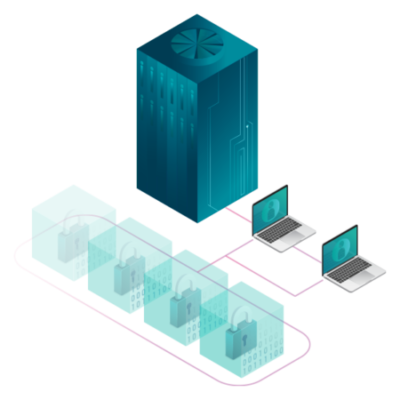Before its widespread adaption, the internet was a high-tech, esoteric invention available to just a few users. When launched in 1991, the world wide web garnered little public attention. However, it steadily gained momentum from its 1993 public release and the subsequent internet boom of 1995. Now, it goes without saying that the internet of things is embedded in pretty much every walk of life. Although it may not be top of mind, subconsciously we are aware that it is in the background running the show.
A similar future is projected for blockchain. Originally developed as a public ledger for cryptocurrency transactions, blockchain’s capabilities have been found to have massive utility elsewhere. In contrast to the dicey trajectory that cryptocurrencies have faced, their blockchain platform has continued to move onward and upward. Developers have recognized its potential and begun to originate applications across industry lines.

Structure and Process
The optimism surrounding blockchain is attributed to its very core structure. The blockchain, or “ledger”, is composed of individual components, or “blocks”. Each block is then composed of a header, containing a date/time stamp and other metadata, followed by a chronological list of transactions. In the ledger, anyone anywhere may see the status of an anonymous transaction, while only participants have access to the details — secured through asymmetric encryption.
Blockchain itself is a form of decentralized internet, as opposed to centralized internet, which has traditionally been the standard. When dealing with centralized internet, data and requests pass through one specific server point. In contrast, blockchain is comprised of a network of server points, or “nodes”, dispersed geographically.
To make a transaction, one must initiate a request, which is solicited from the nodes. To verify this request, the nodes run it through an algorithm relying on a majority consensus to push the transaction through. Once verified transactions are combined and built into a block, then connected to existing blocks, forming a chain.
Blockchain Features
The first fundamental characteristic of blockchain technology is that it is immutable. Once a block is date/timestamped, verified, and added to the existing chain; it is permanently archived. Any request to alter data in the chain will be blocked by the nodes in the network.
The ledger is also updated in real-time. These updates are easily accessible from any location, as blockchain’s geographically decentralized structure and network promote the sharing of data and control on a global scale. Over time, this accessibility is continuously improved for both local and global networks.
The second characteristic of blockchain technology is that its decentralized structure is innately highly hack-resistant.
- A single server may be vulnerable to occasional outages and threats from hackers, as it can be targeted as a single point of failure. Blockchain, on the other hand, proves to be more secure resulting from the dispersion of the network’s many servers.
- To change a single record, and go undetected, an individual would have to alter all of the connecting records of transactions, as well as the block containing them.
- Within the network, a single computer is unable to alter the blocks. Instead, a majority of the network must approve changes and implement them simultaneously. In large networks, a majority equates to a tremendous amount of computing power.
- Participants receive personal access codes, or “digital signatures” linking individuals to their own transactions. If an improper change to a record was made, the corresponding individual’s digital signature would be invalidated. The rejection of the original signature would almost certainly raise red flags for the network, alerting them that the records have been changed.
From a privacy standpoint, blockchain also delivers. The anonymity of the ledger protects users’ identities, while the specific details of each transaction are encrypted. If an audit were to be performed, investigators could easily access the full breadth of transactions, verifying records while their PII/PHI remains private.
The Impact on eDiscovery
The EDRM process is characterized by the push to boost efficiency while keeping cost at a minimum, as well as the overarching theme of maintaining data privacy and security. Blockchain’s unique characteristics translate into several advantages is this respect:
- Self-enforced, consistent verification algorithms applied to all transaction requests effectively eliminate the need for intermediary audit and regulation. These self-verifying algorithms can be programmed to maintain fairness and uphold standards, omitting the potential for corruption or malfeasance. In turn, the overall time and cost of a project are reduced as well as risk.
- When dealing with foreign matters, monetary transactions must pass through many banks before reaching the final destination. With blockchain, the intermediaries are omitted. Transactions can be quickly verified and sent from one node to another, with almost immediate verification. This has the potential to reduce operational spend on middlemen in any process.
- The timestamps of the records stored within the blockchain contain a unique identifier, which cannot be changed in any way. This unalterable timestamp maintains the preservation of records, making them extremely secure. Those with access-codes are the only individuals able to view transactions.
- The security of records ties into their retention across the platform. By providing a reliable, accurate history of transactions, both document preservation and production is aided before, during, and after an investigation. This cuts down on both error and fraud.
- All records are easily searchable and updated constantly, translating into higher efficiencies in search and review processes. With its inherent transparency, blockchain also promotes improved documentation and accountability.
Moving Forward
As blockchain is predicted to become as ubiquitous as the world wide web, it is in the best interest of eDiscovery professionals to become knowledgeable about it. Organizations rely on secure, timely, cost-effective eDiscovery, and blockchain delivers exactly this. Early implementation gives organizations a competitive advantage, making quick adaption and adoption key.